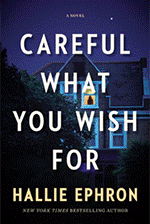After nearly losing her life on her last case, FBI Agent Kelly Jones may never do fieldwork again. Determined to regain her confidence, she joins Jake on his mission—and quickly realizes she's in over her head. Then in the slums of Mexico City, she encounters a former nemesis who's enacting a nightmarish ritual on the weak and vulnerable. Now she has one last, desperate shot to prove herself—by taking down a killer.
**about KIDNAP AND RANSOM by Michelle Gagnon

HANK: You know, here at JRW, we usually we have true crime Tuesday. But Michelle Gagnon's book KIDNAP and RANSOM inspired us to expand--this week at least--to True Crime Thursday.
Michelle explores a dangerous place and a dangerous group, and introduces us to a powerful character, to bring us an important message. (And an amazing story.)
The Real-life kidnapping that inspired KIDNAP & RANSOM
Michelle Gagnon
The initial idea for my latest thriller, KIDNAP & RANSOM, stemmed from a true story.
While researching border issues for THE GATEKEEPER in December of 2008, I stumbled across an article on the kidnapping of Felix Batista. Batista was a security consultant for ASI Global (if you saw the film PROOF OF LIFE, this was the same job held by Russell Crowe’s character).
Michelle Gagnon
The initial idea for my latest thriller, KIDNAP & RANSOM, stemmed from a true story.
While researching border issues for THE GATEKEEPER in December of 2008, I stumbled across an article on the kidnapping of Felix Batista. Batista was a security consultant for ASI Global (if you saw the film PROOF OF LIFE, this was the same job held by Russell Crowe’s character).
Batista personally negotiated the release of more than a hundred hostages over the course of his career. That December he was in Saltillo, Mexico, offering advice on how to handle the uptick in abductions for ransom. While dining with local businessmen one evening, Batista excused himself from the table to take a phone call. On his way out of the restaurant to get better reception, he handed his laptop and a list of phone numbers to his companions in case he didn’t return (this was a man who clearly knew you can never be too careful).
Moments later, an SUV pulled up to the curb and forced Batista was forced inside. He hasn’t been seen or heard from since.

The irony of the story grabbed me—the hero becoming the victim, an expert suddenly forced into the position he’d saved so many people from. Stranger still, his kidnapping wasn’t proceeding normally—there was no ransom demand, and no one claimed responsibility for seizing him. It was a true mystery. (And over the next two years, kidnappings and cartel violence in Mexico became increasingly rampant, spilling over the border to such an extent that related articles appeared in the U.S. media nearly every day.)
So I set off to find out more about narcocartels south of the border, and about kidnappings in general. I fixed on Los Zetas, mainly because their backstory was fascinating.

Los Zetas is a gang comprised mainly of former Mexican Army soldiers. They were part of an elite brigade, comparable to the Army Rangers, trained in special operations techniques at Fort Benning. Upon returning to Mexico, they promptly left the Army and went to work for the Gulf Cartel.
Eventually, they branched off on their own, wresting control of drug trafficking operations from rival cartels. In recent years Los Zetas have become increasingly involved in kidnappings, murder-for-hire, extortion, money laundering, human smuggling, and oil siphoning. They’re suspected of killing the 72 migrants found in a mass grave in Tamaulipas last August, and of the murder of American David Hartley on Falcon Lake last September. The DEA considers Los Zetas to be the most violent paramilitary enforcement group in Mexico.
So when it came to villains, the choice was easy.
Last May, I attended the wedding of a friend from Mexico City who had helped tremendously with my research. At the reception, I was seated with some of his relatives. When they found out that my latest novel was set in their hometown, they were enthusiastic…until they heard the title.
“Oh, no,” one uncle said. “You cannot write about that. Mexico City is very safe.”
“Really?” I asked (in all sincerity, might I add). “I heard that most locals know at least one person who has been kidnapped.”
“Well, of course,” they all agreed. Every single person at the table knew someone who had been kidnapped. But as they explained, it’s much worse up north by the border with Texas. There, it’s really a problem.
Mexico is rapidly supplanting Iraq and Colombia as the kidnapping capital of the world. In the past decade, drug cartels and terror groups have seized upon kidnappings as a relatively low-risk source of financing. During a recent election in Russia, one political party’s entire campaign was funded covertly by ransom money.
Many kidnapping victims are held for months, or years. Some continue to be held even though their ransom has been paid. Many never make it home again.
 I dedicated KIDNAP & RANSOM to them, and to people like Felix Batista who devote their lives to freeing them.
I dedicated KIDNAP & RANSOM to them, and to people like Felix Batista who devote their lives to freeing them.************************************
Michelle Gagnon is a former modern dancer, bartender, dog walker, model, personal trainer, and Russian supper club performer. Her bestselling novels have been published in North America, France, Spain, Denmark, Norway, Sweden, Finland, and Australia. Michelle lives in San Francisco, where in her spare time she runs errands and indulges a weakness for Scrabble, stale cinema popcorn, and Hollywood blockbusters. Read more at http://www.michellegagnon.com/












Welcome back Michelle! this book sounds fascinating--and very scary! I have to say my urge to travel to Mexico has been curtailed by the horrors in the news lately. How did you research this gang and how closely did you decide to stick to reality?
ReplyDeleteI picked this up yesterday and I'm really looking forward to reading it.
ReplyDeleteI've loved the first 3 books, so I know I'm in for a good read.
Yes, my family and I--used to go to Mexico all the time--we had a house there. And it was the LEAST scary place.
ReplyDeleteSo frightening how much it's changed.
Welcome Michelle. I can't wait to read this. My daughter used to work on humanitarian issues in Juarez. I am so glad she's back home. The entire border is no longer safe, and even tourist resorts are seeing murders and kidnappings. I bet you'll open eyes to the real dangers.
ReplyDeleteHi Michelle,
ReplyDeleteWelcome to Jungle Red. Your book sounds fascinating. A terrific read.
Since I'm contemplating a book set in Marseille, I'm wondering how you deal with the language issue in your research? Do you speak Spanish. Get an Interpreter or just not need one because there's enough English spoken?
Hi, Michelle, and congratulations on the new book! I love Mexico, and especially Mexico City but all of the violence has kept us from going back. Please, share any links that will help us better understand what's going on there and how, if any, there are ways to help (short of writing a book).
ReplyDeleteHi everyone- thanks for having me!
ReplyDeleteRoberta- this was the one and only time that I haven't personally visited the place where much of the book was set. It was just too hard to try to convince my husband that Mexico City was the ideal place to take our four year old for a vacation. Although other sections of Mexico are safer, it is absolutely much more dangerous than it used to be, even in the resort communities (as evidenced by the recent grenade attack in Puerto Vallarta).
So I did most of my research online, and by talking to gang experts in the FBI, contacts from Mexico City, and by reading memoirs written by kidnapping survivors like Ernestine Sodi.
Janet- hope you enjoy the book, be sure to let me know what you think!
I have a few wonderful friends who were born and raised in Mexico City, so they did all of the translation for me- a great help, especially with the slang.
I recently received a lovely note from a friend of the Batista family, thanking me for posting about his abduction. Hallie, to be perfectly frank, the only real way to stop the violence is to destroy the drug cartels, and the only way to do that is to eliminate the demand completely. The irony of all this is that the roots of the current violence stem from the relative success of the war on drugs in Mexico- when there were only a few cartels, they divided the territories and maintained a relative degree of peace. But by eliminating those with arrests of the major players, the government cut off the head of the Hydra, and dozens of others sprang up to take their place and vie for dominance. No easy solutions, and it just seems to keep getting worse.